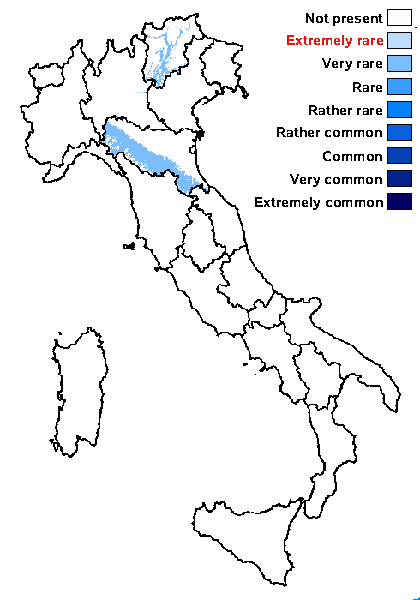Sarcogyne coronata Jatta
Fl. Ital. Crypt., Lichenes, 3: 352, 1910
Synonyms: Biatorella coronata (Jatta) Zahlbr.
Distribution: N - TAA, Emil.
Description: Thallus crustose, episubstratic, rather thick, white to yellowish, continuous to finely rimulose. Apothecia lecideine, at first punctiform and semi-immersed, then subsessile, circular in outline, with a black (turning reddish brown when wet) but bluish-pruinose, urceolate disc, a darker, hardly prominent proper margin, and a persistent, whitish-farinose thalline rim. Epithecium brown; hymenium colourless; paraphyses thread-like, coherent, simple to sparingly branched, regularly septate, thickened at apex; hypothecium black-brown. Asci multispored. Ascospores 1-celled, hyaline, oblong to ellipsoid, 3-6 x 1.5-2 μm. Photobiont chlorococcoid. Spot tests: thallus K-, C-, KC-, P-, UV-. Chemistry: without lichen substances.
Note: a very poorly understood species described from Trentino near Arco, known from the type collection and also reported from Emilia-Romagna (see Nimis 1993: 646); the type material urgently needs further study, perhaps the species does not belong to Sarcogyne.
Growth form: Crustose
Substrata: rocks
Photobiont: green algae other than Trentepohlia
Reproductive strategy: mainly sexual
Poorly known taxon in need of further study
Commonnes-rarity: (info)
Alpine belt: absent
Subalpine belt: absent
Oromediterranean belt: absent
Montane belt: absent
Submediterranean belt: very rare
Padanian area: absent
Humid submediterranean belt: absent
Humid mediterranean belt: absent
Dry mediterranean belt: absent

Predictive model
Growth form: Crustose
Substrata: rocks
Photobiont: green algae other than Trentepohlia
Reproductive strategy: mainly sexual
Poorly known taxon in need of further study
Commonnes-rarity: (info)
Alpine belt: absent
Subalpine belt: absent
Oromediterranean belt: absent
Montane belt: absent
Submediterranean belt: very rare
Padanian area: absent
Humid submediterranean belt: absent
Humid mediterranean belt: absent
Dry mediterranean belt: absent

Predictive model
 INDEX FUNGORUM
INDEX FUNGORUM
 GBIF
GBIF
 DOLICHENS
DOLICHENS

